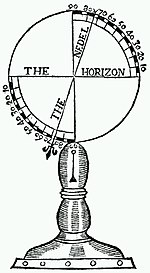
Summary
Robert Norman was a 16th-century-English mariner, compass builder, and hydrographer who discovered magnetic inclination, the deviation of the Earth's magnetic field from the vertical.

Work edit
Robert Norman is noted for The Newe Attractive, a pamphlet published in 1581[1] describing the lodestone (magnet) and practical aspects of navigation. More importantly, it included Norman's measurement of magnetic dip, the incline at an angle from the horizon by a compass needle discovered by Georg Hartmann in 1544. This effect is caused by the Earth's magnetic field not running parallel to the planet's surface. Norman demonstrated magnetic dip by creating a compass needle that pivoted on a horizontal axis. The needle tilted at a steep angle relative to the horizon line.
Magnetic inclination and local variations were known before Robert Norman, but his pamphlet had a greater influence than the earlier work[citation needed].
Writings edit
- Norman, Robert (1721) [First published in 1581]. The newe attractive: shewing the nature, propertie, and manifold vertues of the loadstone : with the declination of the needle, touched therewith under the plaine of the horizon (Reprint ed.).
See also edit
References edit


